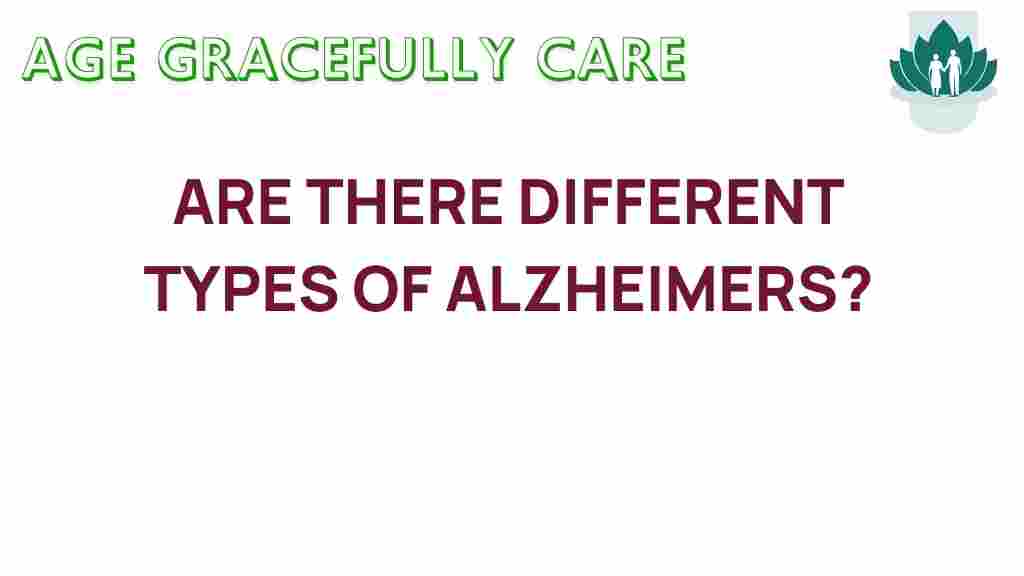Unraveling the Complex Tapestry of Alzheimer’s Types
Alzheimer’s disease is one of the most prevalent forms of dementia, leading to significant cognitive decline and impacting millions of individuals and their families worldwide. Understanding the various Alzheimer’s types is crucial in managing symptoms, diagnosis, and future research. This article aims to explore the different types of Alzheimer’s disease, from early-onset to vascular dementia, and provide a comprehensive overview of their characteristics, diagnosis, and treatment options.
Understanding Alzheimer’s Types
Alzheimer’s disease is not a single entity but a collection of related disorders that can manifest in different ways. Here are the primary types of Alzheimer’s:
- Early-Onset Alzheimer’s Disease
- Late-Onset Alzheimer’s Disease
- Familial Alzheimer’s Disease
- Vascular Dementia
1. Early-Onset Alzheimer’s Disease
Early-onset Alzheimer’s occurs in individuals typically under the age of 65. It is less common but often more aggressive than late-onset forms. Symptoms can include:
- Memory loss
- Language difficulties
- Difficulty with problem-solving and planning
- Changes in mood and personality
This type of Alzheimer’s can often be linked to genetic factors, and those with a family history of the disease may be at higher risk. Diagnosis is usually made through a combination of cognitive tests, brain imaging, and genetic testing.
2. Late-Onset Alzheimer’s Disease
Late-onset Alzheimer’s disease typically affects older adults, with symptoms gradually worsening over time. Key symptoms include:
- Memory loss
- Difficulty recognizing familiar faces or places
- Confusion about time or place
- Withdrawal from social activities
Late-onset Alzheimer’s is the most common form, and while the exact cause is not fully understood, factors such as age, genetics, and lifestyle may play significant roles.
3. Familial Alzheimer’s Disease
Familial Alzheimer’s is an inherited form of the disease that is caused by mutations in specific genes. This type is rare and accounts for less than 5% of all Alzheimer’s cases. Symptoms are similar to those of other Alzheimer’s types, but they tend to appear at a younger age.
Genetic testing can confirm familial Alzheimer’s, making it possible for at-risk individuals to make informed decisions about their health and future.
4. Vascular Dementia
Vascular dementia is often caused by reduced blood flow to the brain, often as a result of strokes or other issues affecting blood vessels. Symptoms can overlap with those of Alzheimer’s types, including:
- Confusion
- Difficulty concentrating
- Memory problems
- Impaired judgment
While vascular dementia is a separate condition, it can occur alongside Alzheimer’s, complicating diagnosis and treatment.
Symptoms of Alzheimer’s Types
Recognizing the symptoms of different Alzheimer’s types is essential for early diagnosis and intervention. Common symptoms include:
- Memory loss that disrupts daily life
- Challenges in planning or solving problems
- Difficulty completing familiar tasks
- Confusion with time or place
- Changes in mood and personality
If you or a loved one exhibit these symptoms, it is critical to consult with a healthcare professional.
Diagnosis of Alzheimer’s Types
Diagnosing Alzheimer’s disease involves a multi-faceted approach, including:
- Medical History: A thorough review of symptoms and family history.
- Cognitive Tests: Assessments to measure memory, problem-solving, and language skills.
- Brain Imaging: MRI or CT scans to rule out other causes of cognitive decline.
- Genetic Testing: Helpful in familial Alzheimer’s cases to identify genetic mutations.
Getting an accurate diagnosis is vital for managing symptoms and planning for the future.
Research on Alzheimer’s Types
Research into Alzheimer’s disease is ongoing, with studies focusing on:
- The underlying causes of different Alzheimer’s types
- Potential treatments and interventions
- Preventative measures and lifestyle changes
- Genetic factors and their implications
For more information on current research initiatives, you can visit Alzheimer’s Association Research.
Step-by-Step Process for Managing Alzheimer’s Types
Managing Alzheimer’s disease requires a comprehensive approach. Here’s a step-by-step process:
Step 1: Early Recognition
Being aware of the early signs of Alzheimer’s types can lead to timely intervention. Family members should be educated on the symptoms to look for.
Step 2: Seek Professional Help
Consult with a healthcare provider if symptoms arise. A timely diagnosis can help in planning appropriate care and treatment.
Step 3: Create a Care Plan
A personalized care plan should be developed, including:
- Medical management of symptoms
- Support for daily activities
- Therapeutic interventions
Step 4: Engage in Support Networks
Connecting with local or online support groups can provide emotional support and resources for both patients and caregivers.
Step 5: Focus on Lifestyle Changes
Implementing lifestyle changes can slow cognitive decline. Consider:
- A balanced diet rich in antioxidants
- Regular physical activity
- Mental exercises and social engagement
Troubleshooting Common Challenges
Managing Alzheimer’s types can be challenging. Here are some common issues and troubleshooting tips:
Challenge 1: Communication Difficulties
Tip: Use clear, simple language and maintain eye contact. Be patient and give the person time to respond.
Challenge 2: Behavioral Changes
Tip: Establish a routine to provide structure and familiarity, which can help reduce anxiety.
Challenge 3: Safety Concerns
Tip: Modify the living space to minimize risks, such as removing tripping hazards and securing dangerous items.
Conclusion
Understanding the various Alzheimer’s types is crucial for effective management and support. With ongoing research, there is hope for better treatments and ultimately a cure. If you or someone you know is experiencing symptoms of cognitive decline, early intervention can make a significant difference in quality of life. Stay informed, seek help, and connect with resources to navigate the complexities of Alzheimer’s disease.
For more resources, visit the Alzheimer’s Association for comprehensive information on Alzheimer’s types, symptoms, and support systems.
This article is in the category Health and created by AgeGracefullyCare Team
